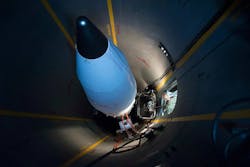Northrop Grumman to develop Ground-Based Midcourse Defense (GMD) Weapon System in $3.3 billion contract
HUNTSVILLE, Ala. – U.S. military ballistic missile defense experts are choosing Northrop Grumman Corp. to follow through with the next Ground-Based Midcourse Defense (GMD) Weapon System (GWS) program to help protect the Continental U.S. from nuclear ballistic missile attack.
Officials of the U.S. Missile Defense Agency (MDA) in Huntsville, Ala., announced a potential $3.3 billion five-year contract Friday to the Northrop Grumman Mission Systems segment in Huntsville, Ala., to field the next GMD Weapon System system.
The GMD is the U.S. anti-ballistic missile system for intercepting incoming warheads in space during the midcourse phase -- or roughly halfway between launch and impact. The GMD is deployed at Fort Greely, Ala., and Vandenberg Space Force Base, Calif., and has interceptors and sensors on land, at sea, and in orbit.
Northrop Grumman will handle GMD Weapon System systems engineering, design, development, integration, testing, and fielding of software and hardware, new requirements like the Next-Generation Interceptor (NGI), and evolving threats.
The GMD Weapon System develops integrated battle plans based on sensor data. It consists of the GMD fire-control system that provides threat assessment and engagement planning; GMD communication network that links GMD to external sensors and systems; GMD launch management that is the pre-launch interface between the GMD fire control and the interceptor; and the GMD in-flight interceptor communication system that connects the GMD fire control and the interceptor to update the missile during flight.
Northrop Grumman will craft an open and modular GMD Weapon System architecture that involves radars, space sensors, missile interceptor weapons, and a command and control system.
Last year the MDA chose teams led by Northrop Grumman and Lockheed Martin Corp. to start developing the GMD Weapon System and bring the project into the technology-development and risk-reduction phase. Boeing, which teamed with General Atomics Electromagnetic Systems and Aerojet Rocketdyne, was not selected to move forward with the program.
On this contract Northrop Grumman will do the work in Huntsville, Ala., and should be finished by July 2027. For more information contact Northrop Grumman Mission Systems online at www.northropgrumman.com, or the Missile Defense Agency at www.mda.mil.

John Keller | Editor-in-Chief
John Keller is the Editor-in-Chief, Military & Aerospace Electronics Magazine--provides extensive coverage and analysis of enabling electronics and optoelectronic technologies in military, space and commercial aviation applications. John has been a member of the Military & Aerospace Electronics staff since 1989 and chief editor since 1995.

